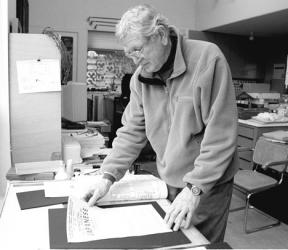Executive Order No. 9066 sent 120,000 people of Japanese ancestry to internment camps on U.S. soil.
The order, signed Feb. 19, 1942, by President Franklin Roosevelt, resulted in the forcible imprisonment of men, women and children for the duration of the war.
For artist Lee Wexler, this shameful part of American history is something to be remembered. On this year’s anniversary of the signing of the order, Wexler’s dark, moody watercolors depicting life in the camps will be on display in Langley.
They tell a story he cannot forget, and one he wants others to learn.
“I had to respond in my way,” he said. “It was important for me to relieve my angst, yet tell the story.”
The internment camps were scattered all over the interior west in isolated desert areas in California, Utah, Idaho, Colorado and Wyoming.
Wexler’s paintings of one camp, Manzanar, will be on display at Gaskill-Olson Gallery in Langley, Feb. 18-25.
Wexler, who grew up in California, became aware something was happening to Japanese people while in high school.
“I was a junior in 1942. One day Japanese students were in school, the next day they were gone, without explanation.”
He also recalls the many Japanese farmers living in the valley near his home.
“I remember the Japanese farmers working in their fields and the wonderful smell of fresh lettuce and celery. Then the fields were empty.”
Following high school Wexler gained a Masters in Fine Arts Degree, owned a graphics art firm and taught at California State University. But he never forgot what happened in 1942.
In 1977 Wexler met with Amy Uno Ishii, who had been a child in Manzanar, one of the camps in California. Wexler spent time with her and while she talked about her experience in the camp, he sketched. From those sketches and her memories, Wexler’s developed his paintings.
Before Wexler met Ishii, she had successfully convinced the state of California to add the words “concentration camp” to the sign at Manzanar.
“It was very important to her that people understood the situation of the imprisonment,” he said. “They were not mistreated in the sense we understand, but they were humiliated and and forced into decades of economic hardship following the war.”
In the camps, people lived in tar paper barracks that could house three or four families with only sheets hung up for privacy. Residents set up classrooms for their children and tried to preserve their way of life. But the camps were surrounded with barbed wire and guard towers with guards instructed to shoot escapees.
One of Wexler’s paintings is of a kite painted with the Stars and Stripes flying over the camp. He said the camp’s “yes boys” flew the kite every July 4 to prove their loyality to the United States.
“Obviously it had no affect,” Wexler said.
But Japanese Americans were truly loyal. According to records and research done by Wexler and others, thousands of Japanese Americans served in military intelligence and the Army’s 442 Regimental Company Team, a Japanese-American group that was the most decorated for its size and length of service in American military history.
All the camps closed by 1946. Executive Order No. 9066 was rescinded by Roosevelt in 1944. In 1965 new immigration legislation for the first time called for Asians to be treated the same as Europeans in immigration matters.
On Dec. 27, 1969 the first annual Manzanar Pilgrimage took place. These trips back to Manzanar would inspire pilgrimages to other concentration camps in the years to come.
On Aug. 10, 1988 President Ronald Reagan approved individual payments of $20,000 to each surviving internee and a $1.25 billion education fund among other provisions.



